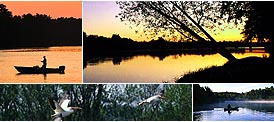
| Redfish | Sailfish | Sharks | Sheepshead | Snapper | Snook | Spanish Mackerel | Spotted Seatrout | Tarpon |

SNAPPERS
Regulations
10" minimum size limit for Gray (Mangrove), 8" minimum size limit for Lane, 16" minimum size limit for mutton, 15" minimum size limit (Gulf side) and 20" minimum size limit (Atlantic side) for Red, 12" minimum size limit for Yellowtail; no closed season; 10 per person per day aggregate limit of all snapper species with these exceptions: no more than 5 of the 10 snapper per person per day can be gray snapper, lane snapper harvested in the Gulf of Mexico are not subject to aggregate limit. more exceptions the snapper bag limits.
General Information
The rules for snapper fishing are complicated; perhaps unduly so according to many anglers. But, with 15 species of snappers in Florida's waters, the popularity of the fish with anglers, and the slow growth rate of these species, the regulations are and will continue to be necessary if overfishing is to be avoided.
Distribution
The five most common species are the mangrove (also known as gray), lane, red, yellowtail and mutton. Mangrove snapper range from mangrove and salt marsh fringed back bays to offshore hard bottom areas, wrecks, and coral reefs. Lane snapper have a state-wide distribution but tend to leave the northern half of Florida during the colder months of the year. It is the smallest of the major species, maturing by the time it is 6 inches long.
Red snapper is most abundant in the deeper offshore waters of the northern part of the state. As evidence of the fish's slow growth rate, scientists who have done growth studies of red snapper estimate that a 20 year old red snapper only weighs about 35 pounds.
Yellowtail snapper have a bright yellow streak on the side of the fish's body running from head to tail. The best place to catch this species is in southeast Florida, especially the Keys. Another Keys specialty is the mutton snapper, the last of the top five species. It is an occasional catch in the offshore waters of other parts of the state.
Tackle and Techniques
When fishing inside waters for mangrove snapper and offshore for lane snapper, a light spinning or bait-casting tackle with 6-12 pound test line, the workhorse of the backwater anglers, will suffice. When heading offshore where you can encounter much larger specimens, boat tackle with 20-30 pound test line and a heavy monofilament leader will be necessary.
One unique ways to catch mutton snapper is fishing the flats in the Florida Keys. It is the only species that routinely visit these flats, places where anglers traditionally stalk permit. Fortunately the same tackle, a 7 foot spinning rod with a reel with 6-12 pound test line or a 7 to 9 weight line and corresponding rod and reel, used for doing battle with a permit works for muttons.
Snapper fishing is among the easiest styles of saltwater angling to learn. You drop your bait in the water, usually down to the bottom unless you're fishing for snapper and using a a chum slick, the fish finds it and bites and you try to get the fish to the boat. It sounds boring but any fish weighing more than a few pounds will give you a good fight and quickly change your mind.
Bait
Talk about a non-picky feeder. Snapper will take live shrimp, small live pinfish, squirrel fish, and ballyhoo or chunks of cut bait. These also happen to be the same treats that attract grouper.
Using chum to get snapper in a feeding mode is another way to catch fish. It is the standard method for catching yellowtail snapper when fishing offshore from the Keys and any place you fish at night for any snapper species.
When targeting mutton snapper on the flats, try a small live crab if they are available or a live shrimp. Soft plastic crab lures are the top artificial bait and crab pattern flies or streamers that imitate baitfish are the choices for fly fishers.
Secrets to Success
* Snappers actively feed after the sun goes down. Try fishing your favorite offshore wreck or reef at night and use a chum slick to let the fish know you're there. The chum can attract hundreds of fish off the bottom and provide everyone on the boat with enough action and fish in the cooler.












